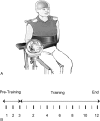Motor effort training with low exercise intensity improves muscle strength and descending command in aging
- PMID: 27310942
- PMCID: PMC4998428
- DOI: 10.1097/MD.0000000000003291
Motor effort training with low exercise intensity improves muscle strength and descending command in aging
Erratum in
-
Erratum: Medicine, Volume 95, Issue 24: Erratum.Medicine (Baltimore). 2016 Aug 7;95(31):e5074. doi: 10.1097/01.md.0000490009.39850.74. eCollection 2016 Aug. Medicine (Baltimore). 2016. PMID: 31265618 Free PMC article.
Abstract
This study explored the effect of high mental effort training (MET) and conventional strength training (CST) on increasing voluntary muscle strength and brain signal associated with producing maximal muscle force in healthy aging. Twenty-seven older adults (age: 75 ± 7.9 yr, 8 women) were assigned into 1 of 3 groups: MET group-trained with low-intensity (30% maximal voluntary contraction [MVC]) physical exercise combined with MET, CST group-trained with high-intensity muscle contractions, or control (CTRL) group-no training of any kind. MET and CST lasted for 12 weeks (5 sessions/week). The participants' elbow flexion strength of the right arm, electromyography (EMG), and motor activity-related cortical potential (MRCP) directly related to the strength production were measured before and after training. The CST group had the highest strength gain (17.6%, P <0.001), the MET group also had significant strength gain (13.8%, P <0.001), which was not statistically different from that of the CST group even though the exercise intensity for the MET group was only at 30% MVC level. The CTRL group did not have significant strength changes. Surprisingly, only the MET group demonstrated a significant augmentation in the MRCP (29.3%, P <0.001); the MRCP increase in CST group was at boarder-line significance level (12.11%, P = 0.061) and that for CTRL group was only 4.9% (P = 0.539). These results suggest that high mental effort training combined with low-intensity physical exercise is an effective method for voluntary muscle strengthening and this approach is especially beneficial for those who are physically weak and have difficulty undergoing conventional strength training.
Conflict of interest statement
The authors have no conflicts of interest to disclose.
Figures






References
-
- Decety J, Grezes J. Neural mechanisms subserving the perception of human actions. Trends Cogn Sci 1999;3:172–8. - PubMed
-
- Malouin F, Bellevillem S, Richards CL, et al. Working memory and mental practice outcomes after stroke. Arch Phys Med Rehab 2004;85:177–83. - PubMed
-
- Sharma N, Pomeroy VM, Baron JC. Motor imagery: a backdoor to the motor system after stroke? Stroke 2006;37:1941–52. - PubMed
-
- Pascual-Leone A, Nguyet D, Cohen LG, et al. Modulation of muscle responses evoked by transcranial magnetic stimulation during the acquisition of new fine motor skills. J Neurophysiol 1995;74:1037–45. - PubMed
Publication types
MeSH terms
Grants and funding
LinkOut - more resources
Full Text Sources
Other Literature Sources
Medical
Miscellaneous

